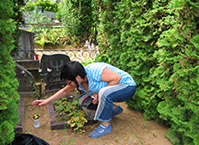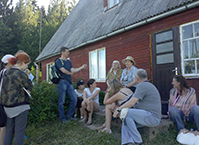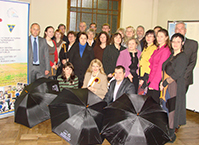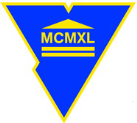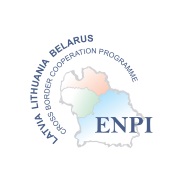E-MUSEUM “VITAMEMORIAE”: COLLECTION AND RESEARCH
Foto
To record people’s life stories, traditions, customs, rituals, rare photographs, old documents, ethnographic differences in funeral rites, etc. the researchers of Daugavpils University and Yanka Kupala Grodno State University carried out field studies in LV and BY territories: in the villages of Krāslava, Rēzekne, Daugavpils regions (Asūne, Foļvarka, Kruki, Skrudaliena, Indra, etc.) and in Belarus (Braslav and Vitebsk districts). The field studies were implemented in the framework of the project “Popularization of the Centres of Oral History in the LV – BY Cross-Border Area”, ID Nr. LLB–2–143, of the Cross Border Cooperation Programme Latvia–Lithuania–Belarus implemented within the framework of the European Neighbourhood and Partnership Instrument 2007–2013.
During the research and the expeditions, the project implementers collected, segmented, transcribed, and digitized the audio-visual materials (audio and video records, photo evidence). To make the collection of the E-Museum more complete, the field researchers and cemetery researchers of Daugavpils University and Grodno University will segment and systematize the audio-visual materials collected during oral history, cemetery research, folklore and dialectology expeditions of the previous years that until now have not been used, aiming at including the best and most valuable segments of the collection into the E-Museum.
The story tellers whose life stories make the input of the E-Museum are people of various generations, mostly elderly people. The childhood of aged people, who at present are about 80 years old, proceeded in the 1930s, therefore the segmented audio-visual units included in the E-Museum chronologically begin from 1929 and can describe only the respondents’ childhood memories. The memory of the older generation is particularly important for the anthropological and historical research – it shifts the time borders, allows for moving to the events of the past through the viewpoints of those who have experienced those times. The facts can be found in chronicles, but what the witnesses of that time can reveal give the memories colour, scent, involve one into mutual emotional experience. The witnesses of the epoch tell about the events form the viewpoint of their own experience.
To motivate the respondents to share their life stories, the project field researchers used Paul Thomson’s oral history research method – enlarged vision of social history where diverse groups of the society are brought together and share common historical experience.
The research basis is the methodology of a semi-structured interview that envisages focused (guided) reconstruction of the past events and an interviewer only helps the respondents to reconstruct the past.
The oral history collection of the E-Museum is envisaged to be used not only by specialists but also by a greatest possible range of non-specialists, therefore, departing from the academic tradition envisaging a complete script and transcript (written transcription of an audio or video record) of life stories, the project experts agreed to segment 360 most vivid, colourful, expressive, unusual, typological or extraordinary audio-visual units (photo, video and audio testimonies) – thematically complete excerpts, and to systematize them according to the thematic plan that would encompass both the historical processes of the 20th century (from the 1920s-30s) and the most essential events of an individual’s life.
ACCESSIBILITY OF THE COLLECTION
The interviews included into the collection are arranged according to the principle of historicism, anthropologism and personalia, indicating the author’s name and the interviewer’s name and surname.
-
Have you ever happened to participate in Christmas mummery?
Oh, I have happened a lot – since I was a child. Usually, it was not organized. Usually is happened like this – either in some house, or at some neighbour’s, or mainly, if we were …
Researcher: Dr. philol. Valentīns Lukaševičs, Daugavpils Universitāte
Categories: Arvid Ratnieks
-
How was Christmas celebrated?
Christmas in Latgale is more associated with church festivals. Usually, people got up early. The mass at the church was always held in the morning. I don’t know where from the tradition has …
Researcher: Dr. philol. Valentīns Lukaševičs, Daugavpils Universitāte
Categories: Arvid Ratnieks
-
How was Jāņi [Līgo, Midsummer night festival] celebrated?
You know, Jāņi was celebrated also during the soviet times, though all that present-day, I would call it, the modern Latvian propaganda – that Jāņi could not be celebrated, that it was not …
Researcher: Dr. philol. Valentīns Lukaševičs, Daugavpils Universitāte
Categories: Arvid Ratnieks
-
What food and drinks were offered at wedding?
Weddings have always been important events in Latgale. There used to be two types of weddings. The more refined ones were called – for two tables, when the wedding began at the bride’s …
Researcher: Dr. philol. Valentīns Lukaševičs, Daugavpils Universitāte
Categories: Arvid Ratnieks
-
Have you ever heard and experienced such a phenomenon as večerinka [spending evenings together]?
I have heard about vecherinkas from my parents, who told me about the first Latvian times when they were young. Then such events were organized on Saturdays or on public holidays as open-air parties …
Researcher: Dr. philol. Valentīns Lukaševičs, Daugavpils Universitāte
Categories: Arvid Ratnieks
-
Joint work. How did it go? What is the situation now?
It was so. I’ll start from the end. A man once asked me: “What do you like most in joint work?” For me the best thing in the joint work is the moment when the hostess says: “ …
Researcher: Dr. philol. Valentīns Lukaševičs, Daugavpils Universitāte
Categories: Arvid Ratnieks
-
Did people in Soviet times experience any problems related church attendance?
People have problems with attending church at present, too. People themselves create problems. As far as I have observed, one man told me about a great sinner, that now the most active churchgoers …
Researcher: Dr. philol. Valentīns Lukaševičs, Daugavpils Universitāte
Categories: Arvid Ratnieks
-
Have you ever heard any tales, stories, or legends that are related to great events of European history?
In my childhood, a great event was the one that had ended some twenty years before, that was World War II. And here the honourable interviewer is late for some fourteen years. If he had …
Categories: Wartime, Arvid Ratnieks
-
About father and World War I
Story-teller: “You see, we were young country people. We worked in the country. How much did we have? Only some twenty hectares. And, and we had to work from the early childhood, we were used …
Researcher: Dr. philol. Gatis Ozoliņš, Daugavpils Universitāte
Categories: First childhood memory, Helena Bilinska
-
The song holiday in Daugavpils and input of military forces of the USSR to Latvia in 1940
“On our way back from the Song festival, when we were going back, but we, being at the festival, did not know that Russians had entered Latvia in the year forty. We were at Mežvidi, on, on our …
Researcher: Dr. philol. Gatis Ozoliņš, Daugavpils Universitāte
Categories: Beginning of the war, Helena Bilinska


